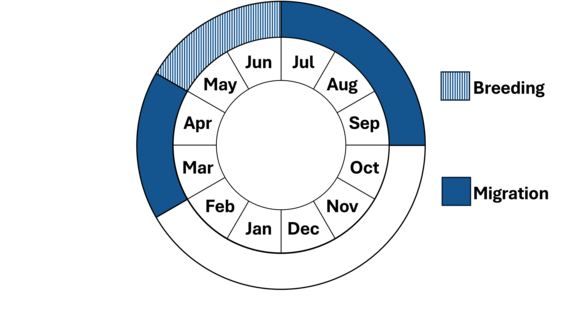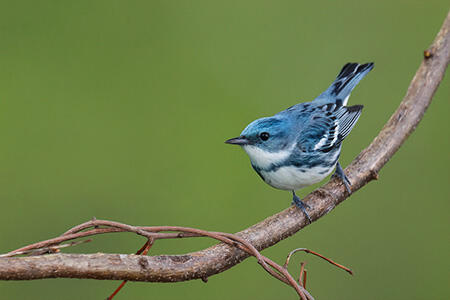- Scientific name: Dendroica cerulea
- Species of Greatest Conservation Need (MA State Wildlife Action Plan)
Description

The cerulean warbler is a small wood warbler that often forages in the forest canopy. The adult male cerulean warbler has a distinctive blue plumage, but the female and young are more cryptic and are often confused with other warbler species. All birds have a pale supercilium and white wing bars. The cerulean warbler has a buzzy song that can easily be mistaken for that of the closely related black-throated blue warbler.
Life cycle and behavior

The cerulean warbler is a small Neotropical migrant songbird that breeds in eastern North America and winters in the foothills of the Andes Mountains in northern South America, where many overwinter on shade-coffee plantations. Most nesters arrive in Massachusetts in early May with males returning slightly earlier than females. They nest on a lateral branch of a deciduous tree (often an oak or hickory) high off the forest floor. They are single-brooded but often renest after a nest failure. Their clutch size is typically 4 eggs that females incubate for 12 days. Chicks fledge from the nest 11 days after hatching and continue to be fed by parents for several weeks. Cerulean warblers are early fall migrants with most departing their nesting grounds between late July and early September.
Population status
Cerulean warblers were once one of the most common birds in the Ohio and Mississippi River Valleys. However, since at least the mid 1900s, this species has undergone one of the steepest declines of any North America bird. During the 1st Massachusetts Breeding Bird Atlas, this species was only reported in a single block, and that had increased to 14 blocks during the 2nd Atlas. This increase in Massachusetts is thought to be primarily a result of a warming climate, and cerulean warblers can be reliably found at specific sites along the Quabbin Reservoir and in the Pioneer Valley. Increases among their northern populations contrast sharply with declines throughout the core of their range. This species is listed as vulnerable by the International Union for the Conservation of Nature (IUCN).
Distribution and abundance
The core of its current range is in the Ohio Hills physiographic region, but breeding populations can be found as far north as Ontario, west as Missouri, and east to Massachusetts. Throughout its range, local populations can be found where suitable habitat exists.
Habitat

The cerulean warbler nests in large patches of mature, deciduous forests that are characterized by large trees and an uneven canopy structure. This type of habitat was historically provided within old-growth forests and is found today in forest gaps, riparian bottomlands, and ridge-top forests. Cerulean warblers are generally found in the mid and upper canopy of the forest.
Healthy habitats are vital for supporting native wildlife and plants. Explore habitats and learn about conservation and restoration in Massachusetts.
Threats
The biggest threat to the cerulean warbler is habitat loss and degradation on both the breeding and wintering grounds. The most substantial threats on the breeding grounds are nesting habitat loss and degradation. The primary threats on the wintering grounds are deforestation and conversion of shade-grown coffee plantations to monotypic sun coffee or pasture.
An additional threat to the species is collisions with buildings and other structures, as approximately 1 billion birds in the United States are estimated to die annually from building collisions. A high percentage of these collisions occur during the migratory periods when birds fly long distances between their wintering and breeding grounds. Light pollution exacerbates this threat for nocturnal migrants as it can disrupt their navigational capabilities and lure them into urban areas, increasing the risk of collisions or exhaustion from circling lit structures or areas.
Conservation
Conservation of large, intact tracts of forest and habitat management is key to the conservation of this species. Conserving old forests and promoting forests with old-growth qualities benefit the cerulean warbler. Forest management practices like shelterwood and selective harvests that open up the canopy structure and mimic natural disturbances like tree-fall gaps and windstorms have been documented to benefit this species.
Bird collision mortalities can be minimized by making glass more visible to birds. This includes using bird-safe glass in new construction and retrofitting existing glass (e.g., screens, window decals) to make it bird-friendly and reducing artificial lighting around buildings (e.g., Lights Out Programs, utilizing down shielding lights) that attract birds during their nocturnal migration.
References
Bakermans, M.H., and A.D. Rodewald. 2009. Think globally, manage locally: The importance of steady-state forest features for a declining songbird. Forest Ecology and Management 258(3):224-232.
Buehler, D. A., P. B. Hamel, and T. Boves (2020). Cerulean Warbler (Setophaga cerulea), version 1.0. In Birds of the World (A. F. Poole, Editor). Cornell Lab of Ornithology, Ithaca, NY, USA. https://doi.org/10.2173/bow.cerwar.01
Sauer, J.R., J.E. Hines, J.E. Fallon, K.L. Pardieck, D.J. Ziolkowski, Jr., and W.A. Link. 2022. The North American Breeding Bird Survey, Results and Analysis 1966 – 2022. Laurel, MD.
Walsh, J., and W.R. Petersen. 2013. Massachusetts Breeding Bird Atlas 2. Massachusetts Audubon Society and Scott & Nix, Inc.
Contact
| Date published: | May 16, 2025 |
|---|